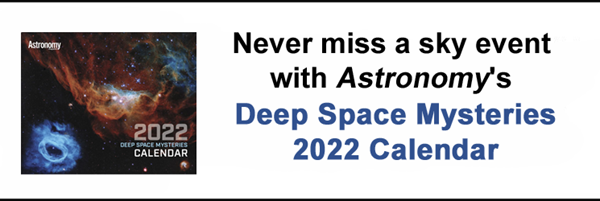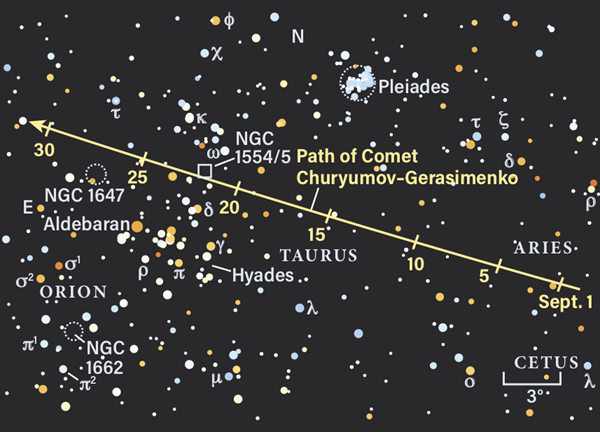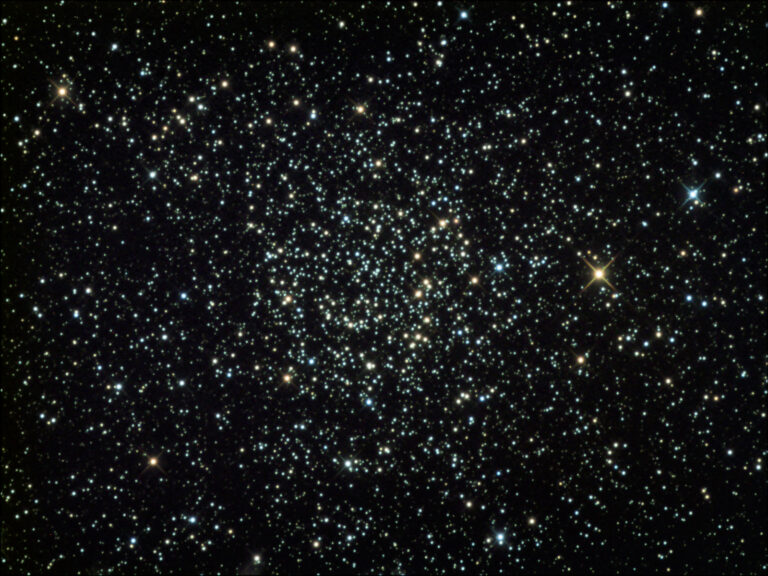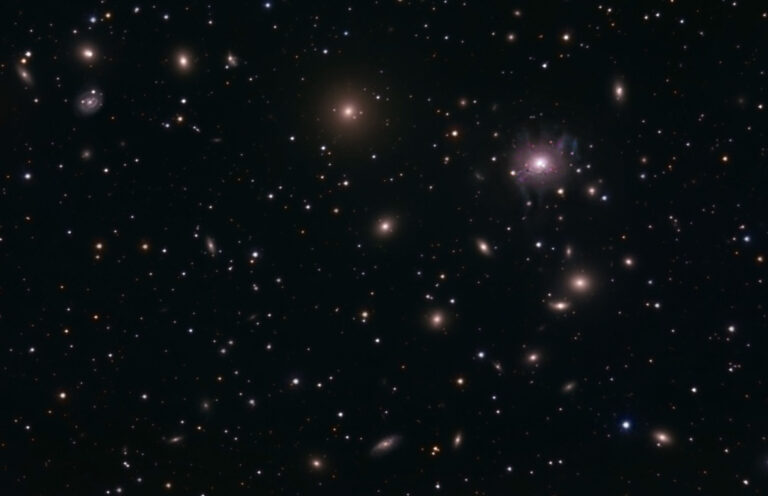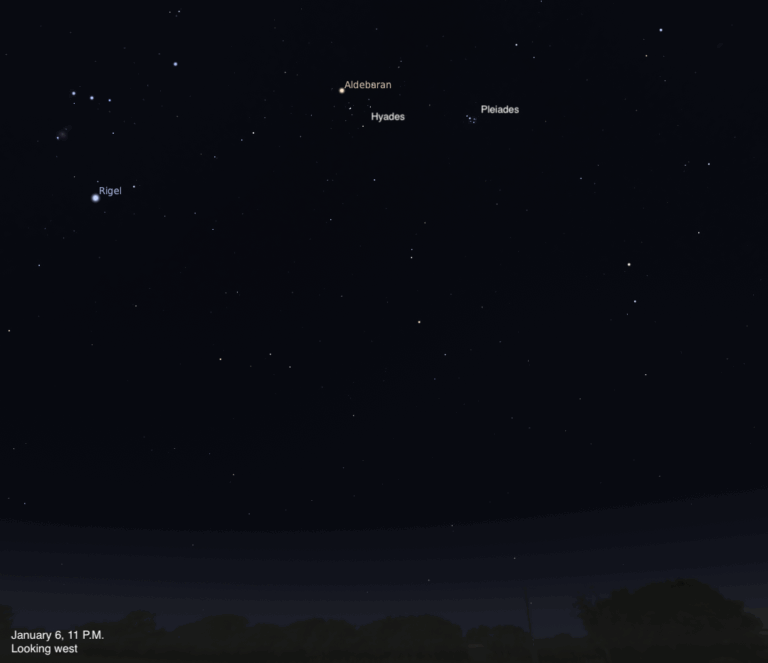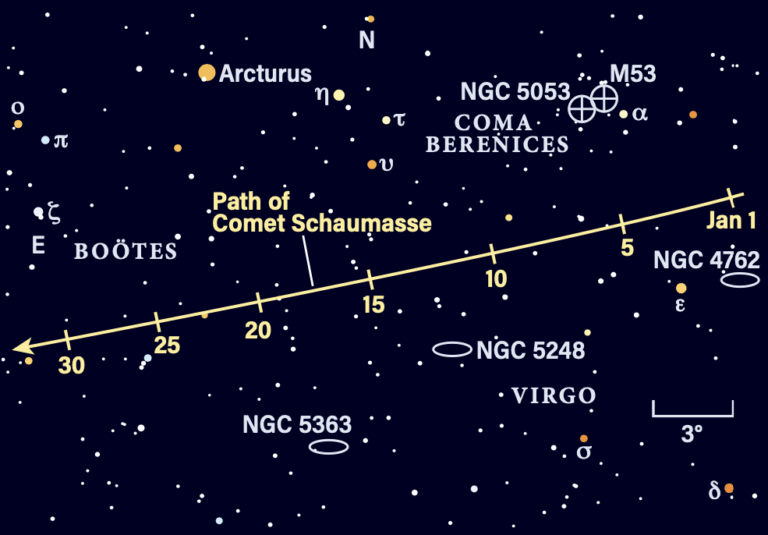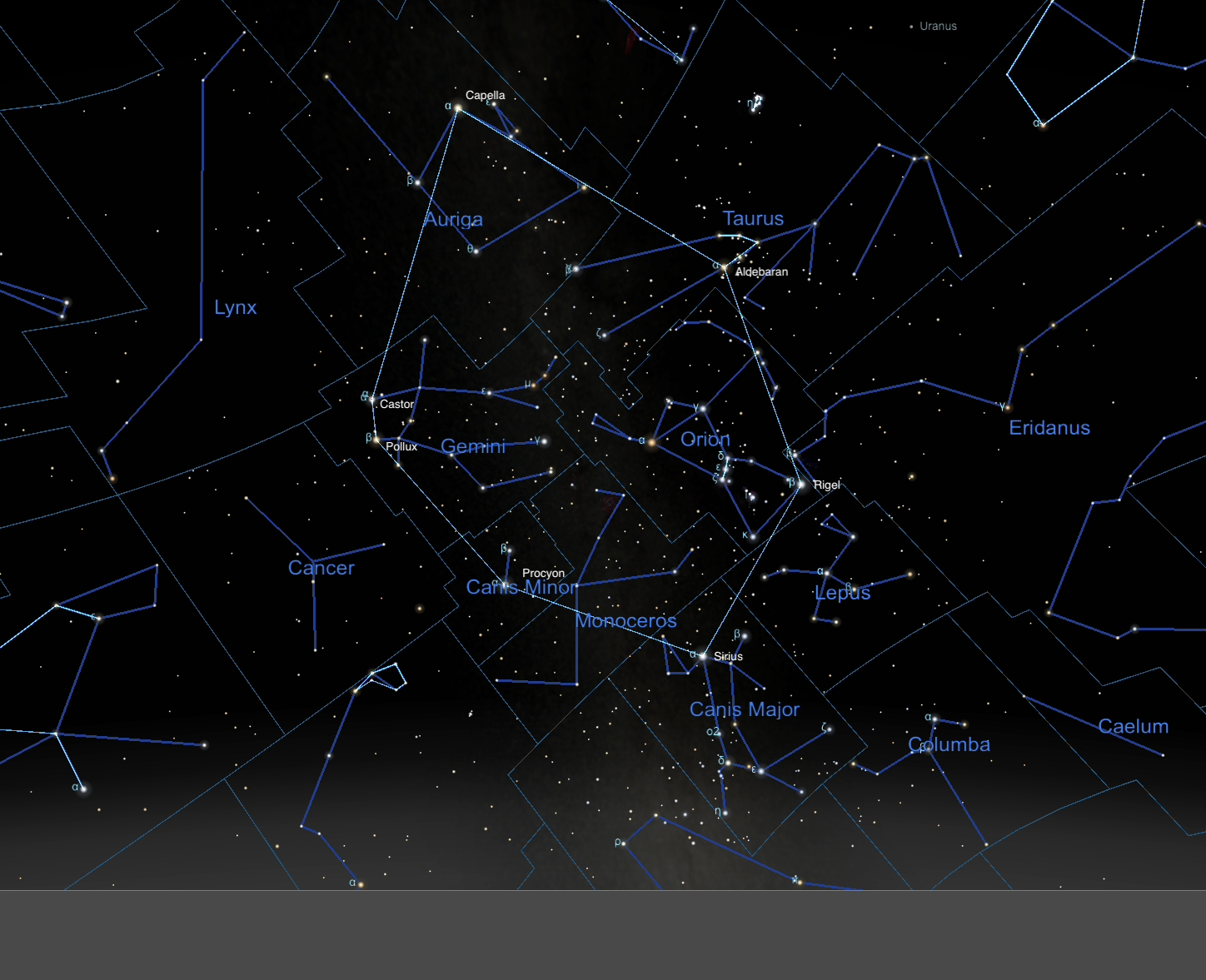Key Takeaways:
Friday, September 17
The Wild Duck Cluster (M11) is a great target this evening. Located in Scutum, it’s still relatively high in the south after sunset. You can find M11 by dropping 1.8° southeast of 4th-magnitude Beta (β) Scuti, also known as 6 Aquilae.
M11 is a bright, rich cluster of nearly 3,000 young stars estimated to be between 220 million and 250 million years old. With a visual magnitude of about 6, a keen-eyed observer might just be able to see it from a dark location — although the Moon may interfere with any attempts to find it without optical aid this evening. However, with either binoculars or a wide-field telescope, this beautiful cluster is easy to find and a real crowd-pleaser. It stretches about 14′ across and its brightest stars form a rough v shape, which is how the cluster earned its name.
Sunrise: 6:43 A.M.
Sunset: 7:05 P.M.
Moonrise: 5:52 P.M.
Moonset: 2:45 A.M.
Moon Phase: Waxing gibbous (88%)
*Times for sunrise, sunset, moonrise, and moonset are given in local time from 40° N 90° W. The Moon’s illumination is given at 12 P.M. local time from the same location.
Saturday, September 18
The Moon passes 4° south of Jupiter in eastern Capricornus at 3 A.M. EDT. Both are setting in the west at that time, about 11° above the horizon and still visible. But if you don’t want to get up early, they’ll be up again this evening, already climbing above the eastern horizon as the Sun sets and now almost 10° apart. That will actually make it easier to zoom in on Jupiter after dark to see some detail, such as its alternating light and dark bands of clouds and four Galilean moons.
Tonight, three moons (in order: Ganymede, Europa, and Io) stretch out to Jupiter’s east — Io is closest to the planet — and Europa sits to Jupiter’s west. If you keep watching long enough, you’ll see tiny Io approach the planet and slip onto the disk just after 11:15 P.M. EDT. It’s followed by its shadow, which appears as a dark spot on Jupiter’s face just after midnight EDT on the 19th (still late on the 18th in other time zones). Io will finish its transit an hour and a half later, and its shadow will finally disappear from the disk around 2:20 A.M. EDT on the 19th.
Sunrise: 6:44 A.M.
Sunset: 7:03 P.M.
Moonrise: 6:24 P.M.
Moonset: 3:55 A.M.
Moon Phase: Waxing gibbous (94%)
Sunday, September 19
Comet hunters will get a window of opportunity this morning to spot Comet 67P/Churyumov–Gerasimenko, currently skimming through Taurus the Bull. As soon as the Moon sets (around 5 A.M. local time), point your telescope up toward Taurus, some 70° high in the southwest. 67P is about two-thirds of the way between the Pleiades (M45) and the Hyades; the former is a tightly knit open cluster of stars, while the latter is a much looser open cluster sprinkled across the Bull’s nose.
You’ll find 67P sitting just 3.2° west-northwest of magnitude 3.8 Delta (δ) Tauri. It’s glowing around magnitude 12 and currently sporting a tail about 3′ long. Slightly brighter — around 11th magnitude — is Comet 4P/Faye, gliding through the other side of Taurus. To find this target, drop about 3.5° due south of Alheka (Zeta [ζ] Tauri). Although it has noticeable tail, Faye does sport a larger circular coma than 67P.
Sunrise: 6:45 A.M.
Sunset: 7:02 P.M.
Moonrise: 6:53 P.M.
Moonset: 5:04 A.M.
Moon Phase: Waxing gibbous (98%)
Monday, September 20
The Moon passes 4° south of Neptune at 5 A.M. EDT. At that time, both are low in the southwest, setting in the constellation Aquarius. If you want a better view of the region, you’ll need to get up a bit earlier to catch them higher in the sky. However, the Moon’s bright light will largely drown out Neptune’s faint, magnitude 7.7 glow. Still, dedicated observers should certainly give spotting the planet a try. It will stand out from the background stars as a “flatter,” blue-gray disk just 2″ wide.
But the real showstopper occurs later tonight: September’s Full Moon occurs at 7:55 P.M. EDT. Known as the Harvest Moon, this Full Moon has something unusual in store. Check out the times for moonrise over the past few days, as well as for the next several nights. You may notice they’re not terribly different. That’s because at this time of year, the angle between the orbit of the Moon around Earth and our eastern horizon is at a minimum. So, the Moon appears to rise at roughly the same time for several nights in a row, and may also appear fully illuminated for several subsequent nights. This is called, perhaps predictably, the Harvest Moon effect.
Sunrise: 6:46 A.M.
Sunset: 7:00 P.M.
Moonrise: 7:18 P.M.
Moonset: 6:10 A.M.
Moon Phase: Full
Tuesday, September 21
By 30 minutes after sunset, magnitude 0.4 Mercury is nearly gone, hovering just 1° above the horizon. Its dim glow also makes it extra challenging to spot in the lingering twilight. Only the brightest stars are starting to pop out against the sky at this time: Arcturus, Antares, Deneb, Altair, and Vega.
But blazing amid the still-invisible stars of Libra is a bright evening star that isn’t a star at all: It’s Venus, shining a brilliant magnitude –4.2 from 11° above the southwestern horizon. Through a telescope, Earth’s sister planet will appear 17″ across and 66 percent lit.
Watch Venus over the next several nights. Rather than setting earlier and earlier, you’ll notice a different trend: The planet is instead hugging the horizon, appearing to scoot sideways toward the south. By the end of the month, it will be halfway through Libra on its way toward Scorpius.
Sunrise: 6:47 A.M.
Sunset: 6:58 P.M.
Moonrise: 7:42 P.M.
Moonset: 7:15 A.M.
Moon Phase: Waning gibbous (99%)
Wednesday, September 22
The autumnal equinox occurs at 3:21 P.M. EDT as the Sun crosses the celestial equator, heading south. The event also marks the first day of fall in the Northern Hemisphere and the first day of spring in the Southern Hemisphere. Those above the equator have likely already noticed the Sun setting earlier each day, as the long daylight hours of summer begin to give way to the shorter days and long, cold nights of winter.
Let’s take the opportunity today to start saying goodbye to a summertime friend: the Summer Triangle. This famous asterism, or unofficial star pattern, comprises three stars from three different constellations: Vega in Lyra, Deneb in Cygnus, and Altair in Aquila. (Remember them from last night? They’re bright and easy to find, appearing shortly after sunset.)
The Summer Triangle is so named because it rides high in the summer nighttime skies, rising as the Sun sets and typically appearing overhead around midnight. Tonight after sunset, you’ll find this stellar triad still high in the southwest, but now heading toward the horizon as the night marches onward. The Summer Triangle will set a little earlier each night as fall stretches on, until its stars eventually disappear altogether from the night sky during winter.
Sunrise: 6:48 A.M.
Sunset: 6:57 P.M.
Moonrise: 8:05 P.M.
Moonset: 8:17 A.M.
Moon Phase: Waning gibbous (97%)
Thursday, September 23
Mercury passes 1.7° south of Spica at 8 A.M. EDT; however, neither is visible at that time. Instead, try looking west as soon as the Sun sinks below the horizon, where Mercury and Spica, still roughly the same distance apart, are setting quickly. See how soon you can spot the pair in binoculars or a telescope, with slightly brighter Mercury sitting to Spica’s lower left. You’ll need a clear horizon to find them and if you can get to higher ground, there’s an even better chance you can catch the pair before first Mercury, then Spica, sets.
Spica, also known as Alpha (α) Virginis, is some 1,900 times brighter than the Sun, which is why it’s so bright in our sky, even at a distance of 250 light-years. It is also a tight binary system, with its two components separated by some one-tenth the distance between Earth and the Sun. Both are blue-white class B stars, and at least one of the two is massive enough to end its life as a supernova when its fuel has been exhausted.
Sunrise: 6:49 A.M.
Sunset: 6:55 P.M.
Moonrise: 8:29 P.M.
Moonset: 9:19 A.M.
Moon Phase: Waning gibbous (93%)
Friday, September 24
The Moon passes 1.3° south of Uranus at noon EDT, although the pair won’t rise until about two hours after sunset. Uranus climbs above the horizon first, followed by the Moon about 25 minutes later. That 25-minute window is a great time to see if you can spot the distant ice giant on its own, although you will likely be somewhat hindered by the turbulent air that clings to the horizon. To find Uranus, first locate bright (magnitude 2) Hamal in northwestern Aries. Drop about 12° down from that star toward the horizon (southeast) to reach Uranus. It’s currently magnitude 5.7 and should be visible with binoculars.
Once the Moon rises, it’s nearly 6° from Uranus. Now several days past Full, the Moon has become a clearly waning gibbous less than 90 percent lit. Turn binoculars or a small scope to the terminator — the line where light and dark meet — to see features on the Moon’s eastern limb (west in our sky) start to fall into darkness. Peeking out from shadow is the western portion of the Sea of Tranquillity, bordered to the northwest by the Sea of Serenity.
Sunrise: 6:50 A.M.
Sunset: 6:53 P.M.
Moonrise: 8:55 P.M.
Moonset: 10:20 A.M.
Moon Phase: Waning gibbous (87%)


